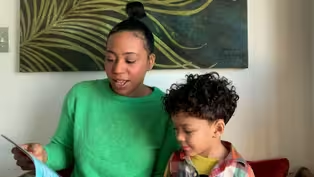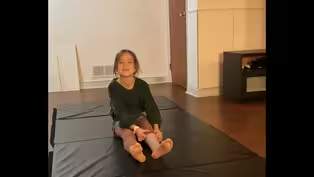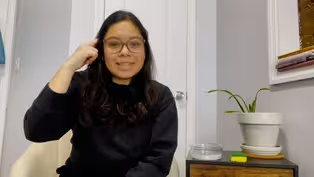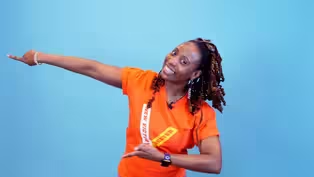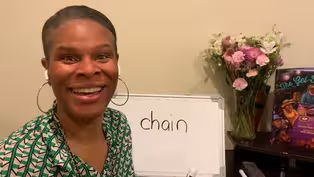
HOW ANIMALS LEARN
Clip: 5/19/2023 | 7m 12sVideo has Audio Description, Closed Captions
Jess Nystrom from the Memphis Zoo explains how animals at the Memphis Zoo learn.
Jess Nystrom from the Memphis Zoo explains how animals learn through training. This helps them to thrive in their zoo habitats and enables some of them to serve as animal ambassadors.
See all videos with Audio DescriptionADProblems playing video? | Closed Captioning Feedback
Problems playing video? | Closed Captioning Feedback
Let's Learn is a local public television program presented by THIRTEEN PBS

HOW ANIMALS LEARN
Clip: 5/19/2023 | 7m 12sVideo has Audio Description, Closed Captions
Jess Nystrom from the Memphis Zoo explains how animals learn through training. This helps them to thrive in their zoo habitats and enables some of them to serve as animal ambassadors.
See all videos with Audio DescriptionADProblems playing video? | Closed Captioning Feedback
How to Watch Let's Learn
Let's Learn is available to stream on pbs.org and the free PBS App, available on iPhone, Apple TV, Android TV, Android smartphones, Amazon Fire TV, Amazon Fire Tablet, Roku, Samsung Smart TV, and Vizio.
Providing Support for PBS.org
Learn Moreabout PBS online sponsorship[bright music] - Many other species go through their own versions of metamorphosis.
Oh, hi everyone!
My name is Jessica and I'm the animal interpreter here at the Memphis Zoo and this is Eric, Charming, and Naveen.
Eric, Naveen, and Charming are ambassador animals.
That means they come out to educate people about how amazing toads and other animals are and how important they are to the world.
Eric, Naveen, and Charming don't just help us learn, but they also learn themselves.
There are so many different ways to learn.
Sometimes we learn best by seeing things or by hearing things.
Toads do not learn well by listening to instructions because they don't understand human language the way that we do.
Instead, they have these really big eyes so they learn best by seeing things.
Let's see some of the other ways that our animals learn.
What is learning anyways?
Learning can be when an adult tells you something and you remember it later, like when an adult tells you to hold a cup with two hands so you don't spill it.
Learning is also when you figure out a puzzle by yourself and you know how to do it the same way next time.
Training is a special type of learning that our ambassador animals do with us keepers.
Their training helps them do their job as an ambassador animal.
We keepers teach them to do a behavior and action by giving them a sign, like a point, and once they do that behavior or action, they get a yummy treat.
This behavior is called target.
Training our animals to do behaviors gives them choice and control over their lives.
[gentle music] Let's find out some other reasons why we train our animals.
Just like humans, animals that are around people need to have manners.
Manners like gentleness and patience are very important for ambassador animals to have.
Being able to sit patiently on glove while I talk about what an amazing animal she is allows guests to be able to admire her and not be worried that she's gonna come flying to their hands.
Being able to take food gently from my hand allows her to be able to get all of her yummy treats and allows all my fingers to stay on my hand.
We have to have manners too.
Saying please and thank you when we want something is better than just taking.
Waiting your turn in line instead of pushing your way to the front makes sure everybody gets a turn.
Manners can always be learned.
If you forget your manners, you can always apologize and try again next time.
I love learning new things.
Playing a new game with friends or learning how to do a craft by myself can be so much fun, but it can also be really frustrating.
Frankie, the African crested porcupine, can get frustrated too.
Like my toad friend, Frankie doesn't understand human speech the way we understand it.
If we ask Frankie to do a behavior and he does not understand what we are asking, he can get frustrated.
Frankie has large teeth and sharp quills that can be dangerous if he gets frustrated all the time.
Also, he might not wanna spend time with us and we wanna make sure that he enjoys training with us.
To help Frankie work through his frustrations in a safe and healthy way, we taught him a home behavior.
Frankie can go to his home, this green square, anytime during the training session and he always gets a reward.
Frustrations are normal for everyone.
I get frustrated.
Your teachers get frustrated.
You get frustrated.
Think about a time where you were frustrated.
What did you do?
Did you raise your voice?
Or maybe you threw an object.
Think about what your home behavior could be.
Instead of going to a green square or eating a carrot, maybe you take a deep breath or count to 3.
1, 2, 3.
Next time you get frustrated, try your home behavior.
Feel all your frustrated feelings and then let them go.
Ask a question or ask for help from a trusted adult on whatever it is that is making you frustrated and you'll learn how to do something new.
This is Gilley, one of our laughing kookaburras.
Gilley already knows how to fly.
She's a bird.
We didn't need to teach her that.
But what we did need to teach her is how to fly and come back to us safely.
Gilley was hatched here at the zoo so she doesn't know how to to live in the wild.
She doesn't know how to hunt for bugs, but she can learn that she can fly all she wants, but she needs to come back when we call her.
That way she can go home safe to her house and eat a nice dinner.
Our animals are the same way.
They like to have fun and hang out with us, their favorite people.
Gilley also gets her favorite food, crickets, and she gets to fly and have fun.
You see, these guys are toads.
That means that they are amphibians.
They breathe and drink through their skin, so if I have anything on my hand and it gets onto them, it can make it hard for them to breathe.
So allowing them to be able to make the choice to move around their enclosure when we're trying to take care of them allows them to be safer and for them to have control.
Training them is also like play hunting, so they have a lot of fun with it, getting to hunt for their food.
We saw how we can train birds and porcupines, but how do I train the toads?
I first make sure they feel comfortable.
I turn off the lights because toads are nocturnal.
They sleep during the day and are awake at night, so they like the dark.
I next mist their pool.
Toads need to have wet skin for them to breathe the best that they can.
And I have their favorite food in the entire world: crickets.
This all makes them feel safe and comfortable and ready to learn.
What is helpful for you to learn?
Maybe you like for it to be quiet so you can focus on what you're doing.
Try different styles of learning, like watching, listening, or getting up and moving around to see what works best for you.
No one is instantly good at a new thing.
It takes doing things over and over again.
Sometimes you might fail or not get it just right, but that's okay.
There is no such thing as perfect.
Practice makes confidence.
Enjoying the activity is what is important, not the results.
Since learning how to target, Charming has become so much bolder and more confident.
He chooses to come out and say hi to guests more often because he knows he can say no and we will listen to him.
The toads aren't the only ones who learned something from target training.
I learned so much.
I learned that I need to be more patient.
Person time and toad time is very different and I need to go at their speed.
I also learned that I need to be proud of myself.
Training dogs, porcupines and birds is very impressive, but training a toad, that's also really impressive.
Not very many people do it.
I am so happy and proud that I've been able to give these toads choice and control.
I'm so happy and proud that I was also able to show that toads can learn just like we can.
Friends, look at us!
We've learned it so much today!
Remember that learning should be fun and should always be done in a safe manner.
Feeling frustrated is completely normal and we should feel proud of all of our accomplishments.
And remember, practice makes confidence, not perfection.
Thank you so much for learning with me, Charming and the rest of the animals here at the Memphis Zoo.
Bye!
Video has Audio Description, Closed Captions
Clip: 5/19/2023 | 9m 55s | Shana Davis reads DINOSAUR RAP by John Foster, illustrated by Debbie Harter. (9m 55s)
JUNE SHOWS HOW TO DO A SOMERSAULT!
Video has Audio Description, Closed Captions
Clip: 5/19/2023 | 53s | JUNE SHOWS HOW TO DO A SOMERSAULT! (53s)
Video has Audio Description, Closed Captions
Clip: 5/19/2023 | 9m 18s | Brenda Salazar introduces Spanish vocabulary as she discusses learning new things. (9m 18s)
Video has Audio Description, Closed Captions
Clip: 5/19/2023 | 10m 17s | Lily Fincher and Omar Etman show how to play a math memory game. (10m 17s)
Video has Audio Description, Closed Captions
Clip: 5/19/2023 | 4m 11s | Asha John from the New Victory Theater does step dancing to music from different cultures. (4m 11s)
Video has Audio Description, Closed Captions
Clip: 5/19/2023 | 11m 11s | Isabel Simmons explores the vowel teams ai and ay. (11m 11s)
Providing Support for PBS.org
Learn Moreabout PBS online sponsorshipSupport for PBS provided by:
Let's Learn is a local public television program presented by THIRTEEN PBS
